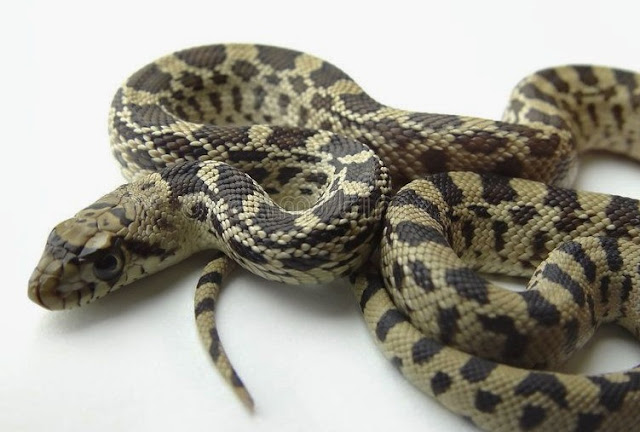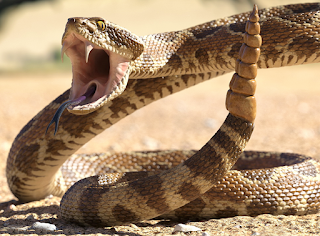bull snake and rattlesnake crossbreed
 |
| bull snake |
bull snake and rattlesnake crossbreed
Want to get to know you gopher snake rattlesnake crossbreed , bull snake rattlesnake hybrid , bull snake rattlesnake mimicry ,bull snake vs rattlesnake , colorado bull snake vs rattlesnake,bull snake acting like rattlesnake
bull snake and rattlesnake crossbreed
The bull snake is a large snake that is not poisonous to humans, spread in the west of Canada, Mexico and the southern regions of the United States. This snake may bite a person quickly if he feels any potential danger or threat, but it does not contain any toxic glands, and therefore there is no harm or harm. On the human being, it is amazing and wonderful at the same time that the bull snake helps farmers keep their crops safe from the evil of rodents and mice, and thus it is a strong friend of the peasant.
Small mammals, specifically rodents, are the main prey of bull snakes. Known foods include mice, baby rabbits, birds, and bird eggs. This species has great ability to control phrays like destructive rodents. The bull snake kills its prey by constricting it.
bull snake
The color is brown or yellow with numerous brown or black spots. Marks along the back and sides are generally black on the neck and tail, and brown in the middle of the body. The tail may have light and dark stripes, mating takes place in April and early May. The eggs are laid during June or early July, with 3-22 eggs. Female bulls lay their eggs in sandy soil, and in deserted burrows, the eggs stick to each other after laying. Hatching occurs in late August through September.
bull snake vs rattlesnake crossbreed
bull snake
It lives in non-dense forests, such as savannah, and may also be found in semi-desert areas
You can usually guess where the bull snake is by its color. The bull snake tends to yellow
And brown, which gives it a camouflage advantage.
And brown, which gives it a camouflage advantage.
Feeding:
All snakes feed on rodents, small mammals, or whatever creature they can hang on to
Year. There are some snakes that feed on other snakes like cobra and python
King Snake: This snake usually feeds on rodents such as mice
And lizards too.
All snakes feed on rodents, small mammals, or whatever creature they can hang on to
Year. There are some snakes that feed on other snakes like cobra and python
King Snake: This snake usually feeds on rodents such as mice
And lizards too.
The bull snake catches the prey, because it pounces on it and squeezes it. Sphincter based snakes
Some prey and spin it in fractions of a second so that it does not give away the prey
The opportunity to defend herself (he has lunch before what she dines on). After no guarantee
If the prey is dead, it begins to swallow, usually with the head to facilitate swallowing. Acids
In the snake's stomach, you analyze everything down to the bone.
Some prey and spin it in fractions of a second so that it does not give away the prey
The opportunity to defend herself (he has lunch before what she dines on). After no guarantee
If the prey is dead, it begins to swallow, usually with the head to facilitate swallowing. Acids
In the snake's stomach, you analyze everything down to the bone.
the behavior:
Usually a bull snake tends to fierce to defend itself. He does one of the strongest imitation
Snakes are poisonous in America. Rattlesnakes. And also what distinguishes this snake is that
Able to make a loud sound very similar to a jingle by blowing the air.
Usually a bull snake tends to fierce to defend itself. He does one of the strongest imitation
Snakes are poisonous in America. Rattlesnakes. And also what distinguishes this snake is that
Able to make a loud sound very similar to a jingle by blowing the air.
rattlesnake crossbreed
 |
| rattlesnake |
The rattlesnake is a venomous snake in the Western Hemisphere. It has a bell at the back of its tail, with which it warns enemies and gives way to it, yet the rattlesnake may not make the sound at times with its bells before it stings the prey.
Types of rattlesnakes
The rattlesnake is a type of poisonous snake. There are about thirty species. And they live in places between southern Canada and Argentina, and the largest number of them live in the dry regions of the southwestern United States and northern Mexico.
Some species are found in a large part of southern America. It is easy to identify a rattlesnake by its bells, which are a group of hollow corneas attached to each other at the end of the tail.
When a rattlesnake walks, it moves its bells, making a rattling sound. Other types of non-venomous snakes - often confused with rattlesnakes - also make noise with their tail as they walk over weeds and dried leaves.
But a closer look at both types, we can identify each type. The rattlesnake always raises its tail when it makes a rattling sound.
As for the non-poisonous snake, it moves its tail over the dry grass and leaves back and forth, making it sound as a result of friction and not as a result of bells.
There are large and small types of rattlesnakes. One of the large snakes is the rhomboid back snake, and lives in the southeastern United States. It is the largest, if not the tallest, of the venomous rattlesnakes.
It got its name on the back due to the presence of crystals (diamond-shaped) outlined in yellow covering its body.
This particular back snake is rarely more than two meters long. And a few other snakes Rattlesnake length over it. There are many types of small rattlesnakes, usually no more than 60 cm in length.
The horned snakes or sidewalk rattlesnake are found in desert areas. The high-nosed rattlesnake and the Crimean rattlesnake belong to this group, which are shorter than the horned rattlesnake
It got its name on the back due to the presence of crystals (diamond-shaped) outlined in yellow covering its body.
This particular back snake is rarely more than two meters long. And a few other snakes Rattlesnake length over it. There are many types of small rattlesnakes, usually no more than 60 cm in length.
The horned snakes or sidewalk rattlesnake are found in desert areas. The high-nosed rattlesnake and the Crimean rattlesnake belong to this group, which are shorter than the horned rattlesnake
Female back snakes (who live in the eastern regions), forest rattlesnakes and northern Pacific rattlesnakes do not become mated until they are three years old, and then give birth every two or three years.
Snakes are usually born in the summer. All rattlesnakes give birth to young and do not lay eggs. Newborn rattlesnakes can handle their own affairs without assistance and bite painful bites.
And biologists still know very little about the vast life of rattlesnakes.
Some people claim that they can determine the age of the rattlesnake by the number of pieces or bells in its tail. They consider that between two and four of those pieces or bells appear every year or every time the snake changes its skin.
But when ten of those pieces gather on the tail of the snake, it begins to fall off. These pieces or bells are similar to hollow rings, each of which is partially fixed on top of the other adjacent to it.
The rattlesnake has a cleft tongue, as shown in the right image, to help it smell. And the image in the middle shows her bony back, which consists of 200 movable joints.
Snakes are usually born in the summer. All rattlesnakes give birth to young and do not lay eggs. Newborn rattlesnakes can handle their own affairs without assistance and bite painful bites.
And biologists still know very little about the vast life of rattlesnakes.
Some people claim that they can determine the age of the rattlesnake by the number of pieces or bells in its tail. They consider that between two and four of those pieces or bells appear every year or every time the snake changes its skin.
But when ten of those pieces gather on the tail of the snake, it begins to fall off. These pieces or bells are similar to hollow rings, each of which is partially fixed on top of the other adjacent to it.
The rattlesnake has a cleft tongue, as shown in the right image, to help it smell. And the image in the middle shows her bony back, which consists of 200 movable joints.
Feeding:
Most rattlesnakes eat birds and young animals, and a few eat amphibians and reptiles.
And these snakes have a benefit as they eat rodents and other animals that are harmful to agricultural crops.
The most dangerous types of snakes with bells are those that have large bells, and they should be watched because they do not ring or bell before they sting or attack.
Rattlesnakes eject their venom through two long hollow canines attached to their upper jaw. The toxin consists of two glands in the upper jaw, each of which is located next to each eye of the snake.
If the two canines are not used for stinging, each tusk is folded back into the mouth of the snake, and when the rattlesnakes are excited in anger, their tusks erect and their mouths open wider.
And these snakes have a benefit as they eat rodents and other animals that are harmful to agricultural crops.
The most dangerous types of snakes with bells are those that have large bells, and they should be watched because they do not ring or bell before they sting or attack.
Rattlesnakes eject their venom through two long hollow canines attached to their upper jaw. The toxin consists of two glands in the upper jaw, each of which is located next to each eye of the snake.
If the two canines are not used for stinging, each tusk is folded back into the mouth of the snake, and when the rattlesnakes are excited in anger, their tusks erect and their mouths open wider.
References
Read also



تعليقات
إرسال تعليق